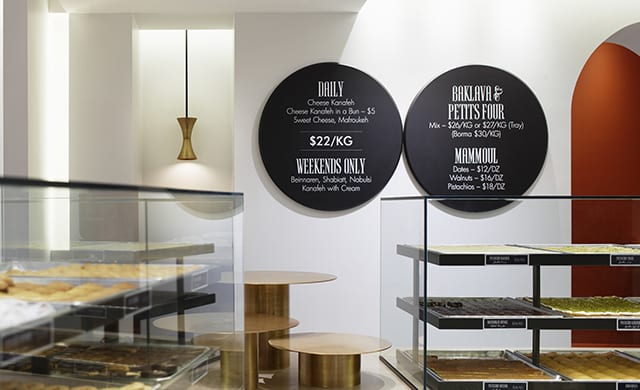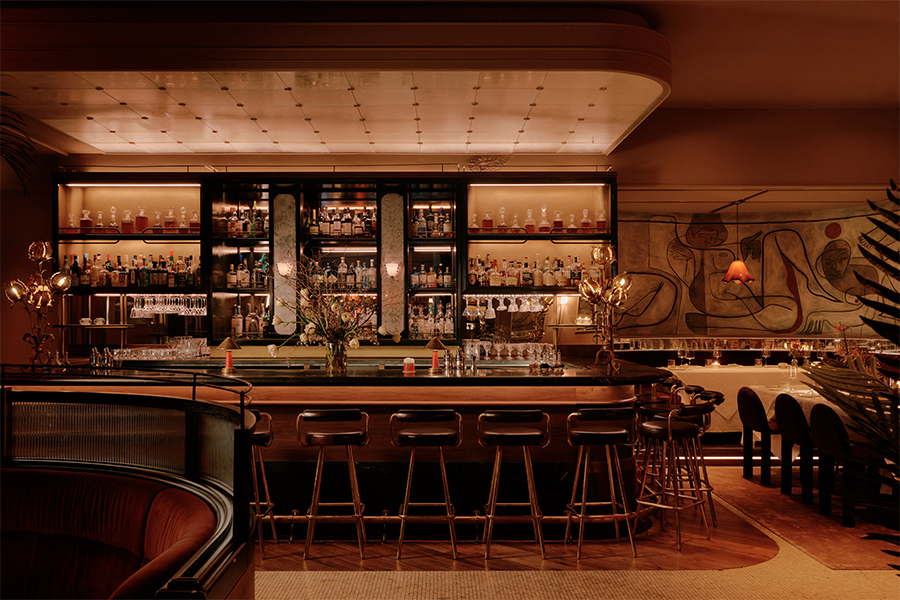“Pâtisserie Royale is about honest forms and intricate details,” says designer Paolo Ferrari, who completed the Middle Eastern bakery’s new Toronto site. “The design evokes the sensibility of a classic patisserie, while evoking the Middle East in a subtle and contemporary way.”
The brand’s founder, Mounzer Jamous, studied under a descendant of Syria’s legendary Mahrousé family at Montreal’s Patisserie Mahrousé before opening a location of his own 15 years ago. This year, Jamous approached Toronto-based Studio Paolo Ferrari to reimagine the brand in a new flagship location in Toronto.
Because everything is baked on-site, the space was designed around the life cycle of the product—from the kitchen to display to weight scale and payment area. The floorplan also needed to enable efficiency in producing the product and elegant presentation to the client. Many customers purchase pastries for takeout, so the design also needed to accommodate lines of people as well as casual seating.
Made of a warm whitewashed ash veneer, the L-shaped counter has an unobtrusive wrapping and point-of-sale area concealed by a minimal black metal transaction surface. Three circular bronze display pedestals show off the selection of sweets and complement bronze pendant lights throughout. “The metal’s warmth adds richness to the palette and elevates the atmosphere,” Ferrari says. A marble floor in a basketweave pattern subtly references Islamic art.
A classical black and white etching of a Syrian village fills an entire wall of the shop, connecting the baked goods back to their long-established roots. “A floor-to-ceiling wall graphic gives the maximum visual impact with minimum financial investment,” Ferrari explains. “The focus of intense red and orange graphics [over the etching] emphasizes the connection to the kitchen beyond and creates a memorable visual impact.” Simple wire frame stools tie into the black and white theme.
Syrian baklava, Pâtisserie Royale’s signature item, is known more for its rusticity, texture, and flavor than its appearance. Baked on aluminum sheets, the sweet looks out of place when showcased in a formal display area. “In a creative solution that reflects the honesty of the baklava and other pastries, we integrated these baking sheets right into the frameless glass display,” he says. Instead of baking the product and transferring it to the display case, a custom T–frame allows each baking sheet to slide into an inexpensive blackened steel framework. LED lights illuminate the pastries and product singnage in a discreet, clear, and moveable system.
“The intent was to elevate the product and create a high-end interior with a modest budget,” says Ferrari. Several existing structural and ductwork elements were too expensive to relocate, so the team used layered architectural planes, including an Islamic arch, to disguise large mechanical ducts.
“Working with a limited budget is often a challenge, but in the case of Pâtisserie Royale, limitations served as launching points for unexpected design solutions,” says Ferrari. “The exercise of creatively working budget limitations, while maintaining design intent was an extremely rewarding aspect of this project.”



